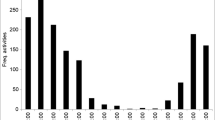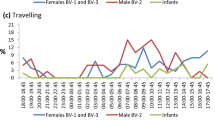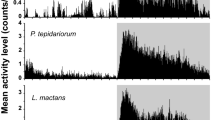Abstract
Opisthacanthus sp. from Panama resembles tropical forest scorpions from other zoogeographical regions in being comparatively inactive and showing some movement in light. Its circadian rhythm is not clear cut. It has a dirty appearance and a repugnatorial odour, a phenomenon not previously recorded in scorpions.
Similar content being viewed by others
References
CLOUDSLEY-THOMPSON, J. L. (1978): Biological clocks in Arachnida. Bull. Br. Arachnol. Soc., 4 (4): 184–191.
CLOUDSLEY-THOMPSON, J. L. (1981): A comparison of rhythmic locomotory activity in tropical forest Arthropoda with that in desert species. J. Arid Environm., 4: 327–334.
CONSTANTINOU, C. (1980): Entrainment of the circadian rhythm of activity in desert and forest inhabiting scorpions. J. Arid. Environm., 3: 133–139.
POLIS, G. A. (1980): Seasonal patterns and age-specific variation in the surface activity of a population of desert scorpions in relation to environmental factors. J. Anim. Ecol., 49: 1–18.
WARBURG, M. R. and BEN HORIN, A. (1979): Thermal effect on the diel activity rhythm of scorpions from mesic and xeric habitats. J. Arid. Environm., 2: 339–346.
Author information
Authors and Affiliations
Rights and permissions
About this article
Cite this article
Cloudsley-Thompson, J.L., Constantinou, C. The circadian rhythm of locomotory activity in a Neotropical forest scorpion,Opisthacanthus sp. (Scorpionidae). Int J Biometeorol 29, 87–89 (1985). https://doi.org/10.1007/BF02189011
Received:
Issue Date:
DOI: https://doi.org/10.1007/BF02189011




